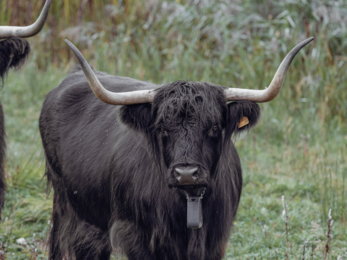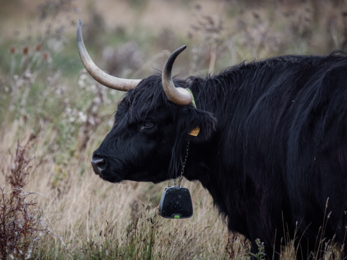Trials of a new technology - Nofence cattle collars - is allowing livestock to roam safely and more extensively across some hard to reach places on our nature reserves. Controlled via an app, the Nofence technology cattle collars create virtual boundaries covering broad areas, achieved using less electric fencing. The collars give audible warnings, signalling a virtual boundary is nearby, indicating to change direction, plus collars track movement in real-time, so animals can be located even when hidden from view.
Being used at Strawberry Hill, Beds, and Barford Meadows and Summer Leys nature reserves, Northants, senior livestock officer Tom Baker explains more: “The system uses satellite GPS: you draw a virtual fence line on a map contained in the app, and the data transfers back to the collars. Once the collar is registered as being inside the virtual fence zone it becomes active, when the animal approaches the virtual boundary the collar will let out an audible warning, which gets progressively higher pitched the closer the animal gets to the virtual fence line. Should it get too close or cross the line, after the highest pitch tone it receives a pulse or mild shock equivalent to an electric fence.
“When our cattle went through an initial learning period of about three days the collars turned out to be extremely effective; they very quickly learnt that the first audible warning meant they needed to turn around, and now very rarely ever receive a pulse, just the audible cues - the data they provide is really quite remarkable.
"We first started using the collars a year ago on six cattle, and after a winter of using those we very quickly made the decision to buy collars for all the cattle due to how effective they proved and how much information they gave us. The cattle don't seem to mind the collars at all; the older cows paid absolutely no attention to the new jewellery around their neck - the calves have a bit of a run around when they're first put on, but after five minutes they appear to be absolutely fine with the idea.
"Currently the collars are being used nationwide by all manner of conservation organisations and are becoming a really popular choice for being able to cut down on physical fencing time when setting up electric fences and really reducing stock checking time when you can track your cows and find exactly where they are on the reserve without having to scour every square inch."


